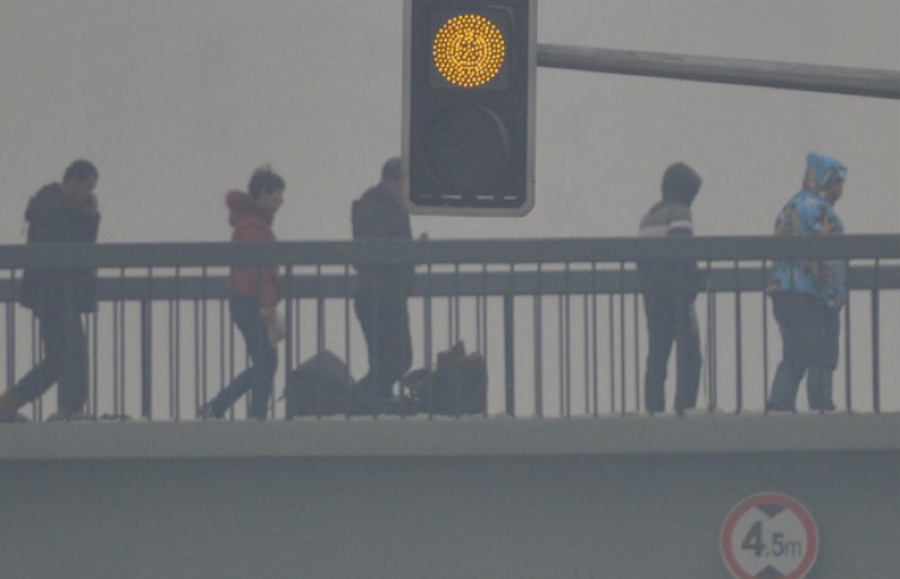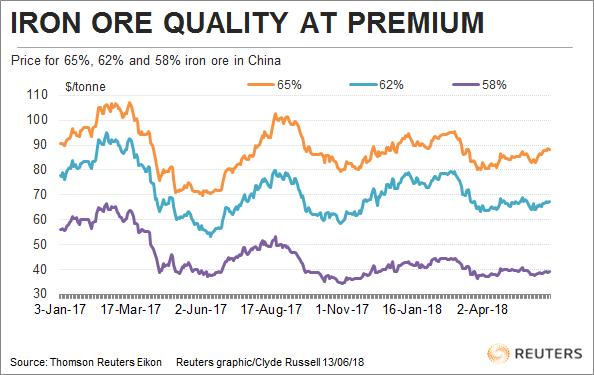
There may be a slight problem with the prevailing theme for the iron ore market this year, namely that China is increasingly interested in using higher-grade ore as part of efforts to boost output and lower per unit pollution.
While Chinese steel mills may well be seeking to boost the use of high-grade iron ore fines and pellets, this isn’t exactly showing up in the import numbers.
The overall figure for Chinese iron ore imports is one of stability, with customs data released on June 8 showing 447.5 million tonnes arriving in the first five months of the year, up a scant 0.7 percent from the same period last year.
The breakdown of the data is somewhat trickier, given that the Chinese government hasn’t released the detailed country-by-country numbers for April, and hasn’t provided a reason for withholding the numbers.
However, vessel-tracking and port data compiled by Thomson Reuters Supply Chain and Commodity Forecasts, which has a strong correlation with the official numbers, indicates that China is still taking large quantities of medium- and low-grade iron ore.
In the first five months of the year 289.3 million tonnes of Australian iron ore arrived at Chinese ports, according to the data.
The vast majority of Australian ore is 62 percent iron content, such as that mined by top producer Rio Tinto, or the lower 58 percent, as produced by the country’s third-ranked miner Fortescue Metals Group.
Very little of Australia’s output is the high-grade 65 percent iron ore fines, or high-grade pellets.

But Australia appears to have increased its share of China’s seaborne iron ore imports so far this year, with the vessel-tracking data showing a 4.9 percent gain from the first five months of 2017.
Brazil, which is the main supplier of higher-grade iron ore, hasn’t been able to increase its share of China’s seaborne iron ore market, according to the shipping data.
China imported 83.1 million tonnes from Brazil in the first five months of the year, down fractionally from the 83.5 million for the same period in 2017.
The Brazilian situation is somewhat complicated by the distribution centre run in Malaysia by Vale, but the shipping data doesn’t show any major spike from the Southeast Asian nation, with China’s imports rising 800,000 tonnes to 8.9 million in the January-May period.
One high-grade iron ore producer that has seen a significant increase of its shipments to China, at least in percentage terms, is Peru. China’s imports in the first five months jumped 19.4 percent.
However, this is off a small base and China’s imports from the South American producer totalled only 8 million tonnes in the first five months of 2018.
Another producer of high-grade iron ore is South Africa, which is the third-biggest supplier to China.
However, China’s imports from South Africa were largely steady in the first five months of the year at 15.4 million tonnes, down from 15.7 million in the same period last year.
HIGH-GRADE TIGHTNESS?
It’s likely that while China’s steel mills are wanting to use higher-grade iron ore, the problem is in sourcing additional supplies.
Much of the new iron ore brought to market in recent years has been of medium or low quality.
This has resulted in the price for higher grade ore outperforming in recent months, with Argus Media assessing 65 percent ore in China at $88.55 a tonne on Tuesday, a premium of $22.90 a tonne to the 62 percent grade.
This means the price of higher-grade ore is currently 35 percent above the medium-grade, which is a substantial widening from the 19 percent premium that prevailed at the end of last year.
The discount for low-grade ore with 58 percent iron content to medium-grade has also widened, going from 27 percent at the end of 2016 to 45 percent by the end of 2017.
Currently, it is 42 percent, according to Metal Bulletin’s assessment of 62 percent ore <.IO62-CNO=MB> at $67.23 a tonne on Tuesday and 58 percent ore.
Overall, the current pricing in the market suggests that supplies of higher-grade iron ore remain tight, but low-grade cargoes are still finding buyers, and the discount has settled into a new range.
Written by Clyde Russell, a columnist for Reuters.
(Editing by Richard Pullin)